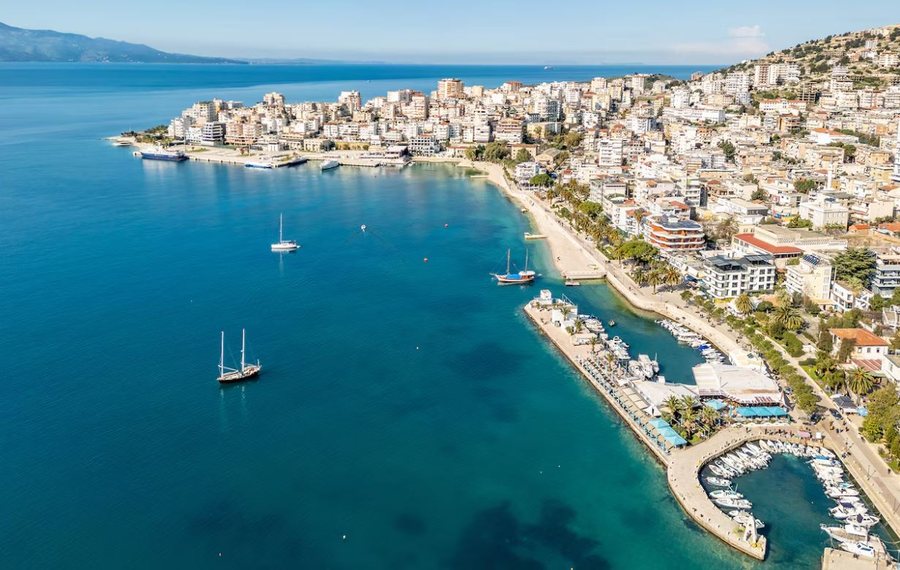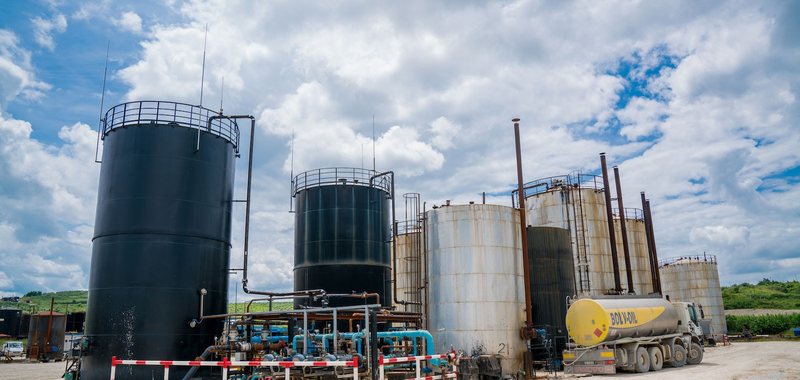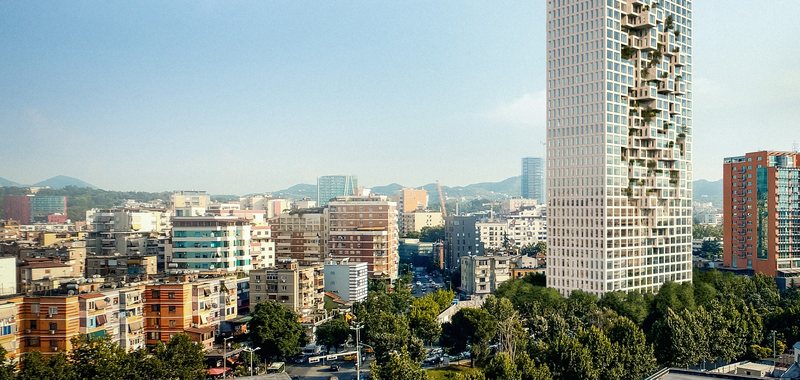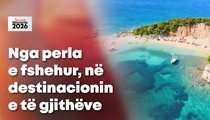'National Geographic': The Albanian Riviera is perfect for a trip. The journey from Vlora to Ksamil is unlike any other in the "Maldives of Europe"!

The prestigious National Geographic has dedicated an article to Albania, describing it as an ideal destination for road trips.
"Why the Albanian Riviera is Perfect for a Road Trip," with this title, National Geographic suggests to its readers, in a long report, to set off on a journey along what it considers one of the most picturesque parts of Albania's coast.
“The Albanian Riviera is more than just the sea; there are traditional villages clinging to hillsides covered in centuries-old olive groves, and ancient ruins alongside remnants of the country’s communist past ,” writes Dom Tulett in his report.
The journey starts from Vlora and ends in Ksamil, which has also been labeled the "Maldives of Europe".
"National Geographic" writes that the Albanian Riviera is filled with countless white-sand beaches, with a coastline of dazzling blue waters, from crowded areas with modern hotels, to isolated bays.
"The main sites can be explored over a weekend, but stay longer to discover more of its archaeological treasures and spend the afternoon leisurely, relaxing on its lesser-known beaches," the article quotes.
"National Geographic" describes the entire journey step by step, stopping in the southern coastal villages, enjoying traditional food, visiting archaeological parks and appreciating the unique nature of the Albanian Riviera.
The two-day trip starts in Vlora, lunch in the village of Radhimë, a trip to the Llogara National Park, continues to Porto Palermo and the evening in Qeparo. The second day starts with breakfast in Qeparo, a trip to Bunec Beach, a trip to the Blue Eye to visit Butrint and Saranda in the evening.
Full article:
Embark on a road trip along one of the most picturesque stretches of Albania's coast, heading to hilltop villages and beaches that could easily replace the tropics, writes Dom Tulett for the prestigious "National Geographic" today.
Stretching along the southwestern flank of the country, from the city of Vlora in the north to the village of Ksamil, the Albanian Riviera has been dubbed the Maldives of Europe. It’s true that countless white-sand beaches dot a coastline of dazzling blue waters, from crowded stretches backed by modern resorts to secluded coves. But the Riviera is more than just the sea; there are traditional villages clinging to hillsides covered in centuries-old olive groves and ancient ruins alongside remnants of the country’s communist past.
Getting to the area is now easier than ever thanks to a growing number of direct flights connecting the UK with Albania’s capital, Tirana, a two-hour journey from Vlora. You can then head south along SH8, the Riviera’s main coastal road, keeping the glorious Ionian Sea in your peripheral view almost the entire way. The region’s highlights can be explored over a weekend, but stay longer to discover more of its archaeological treasures and spend quiet afternoons relaxing on its lesser-known beaches.
Day 1: History and hidden places in the hills
Breakfast: Start in Vlora, Albania’s third-largest city and the birthplace of the modern nation. In Flag Square, the Independence Monument stands next to the spot where the Albanian flag was first raised in 1912, marking the end of centuries of Ottoman rule. To learn more, head down Ismail Qemali Boulevard, named after Albania’s first prime minister, to the National Museum of Independence, which traces the events and key players behind the country’s self-rule.
Then, head five miles south along the coast, past the point where the seas change from Adriatic to Ionian, for lunch at the Fishing Center in the village of Radhimë. Choose from freshly caught fish at the market stall at the shop’s entrance and enjoy it overlooking the small harbor. Afternoon: Hike after lunch in Llogara National Park, an hour’s drive south of Vlora. The Caesar’s Pass Trail starts outside the Sofo Llogara Hotel and follows the route Julius Caesar is said to have taken in pursuit of Pompey, a Roman general and Caesar’s sworn rival. The half-hour climb winds through pine forest, culminating at a platform with views over the Bay of Vlora.
The road that emerges from the mountains offers the first glimpse of the beaches, but resist their temptation and continue towards the bay of Porto Palermo. A fortress, built in 1804 by the Ottoman ruler Ali Pasha, guards the entrance to the bay’s natural harbor. Tours take you through dark passages and chambers, including a frighteningly dark prison.
Evening: Head south for a stroll along the lamp-lit promenade between the bright bars and pebble beach of Qeparo Fushë village. The Sunset Boulevard cocktail bar mixes incredible mojitos with local lemonade and is a great place to watch the sun set over the Greek island of Corfu, which lies to the west of the Albanian coast. A short drive through the hills takes you to the village of Qeparo Fshat, which offers a more traditional way of life. After the fall of communism, it shrank, but its heart remains intact. At Ida & Xhorxhi Restaurant, Ida Thanasi brings out everything fresh and seasonal for customers to eat on the vine-covered veranda, while her husband Xhorxhi serves glasses of raki out front.
Day 2: Get on the water
Breakfast: After a breakfast of soft pancakes (fried dough balls) and Turkish coffee, return to Ida & Xhorxhi Restaurant, wander the steep alleys of Qeparo Village. Many of the dilapidated houses are being rebuilt using materials recovered from other abandoned properties, to preserve the original aesthetic of the village. The alleys lead to panoramic views, overlooking the coast or mountain valleys.
Return to SH8, hugging the hillsides above the sea, before turning onto an unpaved path (just before the 'Lukove' road sign) that leads to Bunec Beach. The gentle waters here are ideal for diving from the stone pier, or exploring by kayak or stand-up paddleboard (rentals are available from the middle of the beach).
Afternoon: Follow the path along Bunec all the way south, where you’ll reach a lunch of grilled koce under the thatched roof of Taverna Nikolas. Then, head away from the shore to the source of the Blue Eye. It gushes from deep below the Bistrica River, creating a dark, iris-like pool within the blue-green of the shallower surroundings. Once, only former dictator Enver Hoxha and high-ranking Communist Party officials were allowed to visit, but it’s now one of Albania’s most popular sites (expect it to be crowded in the summer). A 20-minute walk from the car park leads to an observation platform that offers the best views down the abyss. Swimming in the Blue Eye is not permitted, but you can brave the cold river just a short walk downstream.
Evening: Head back to the coast, heading for Lake Butrint. Its shallow, salty waters are perfect for growing mussels, and farmer Soraldo Nebo organizes boat tours to demonstrate how the shellfish have been harvested here for centuries. Then, watch him prepare the clams, steamed in a garlic broth, or salted and grilled, and put some to the test, accompanied by a glass of Albanian white wine.
See the day break a half-hour drive away at the private beach of the Kep Merli resort, tucked away on the outskirts of the bustling village of Ksamil. Only a limited number of day visitors are allowed at the beach bar; book in advance to enjoy cocktails while relaxing on the softest sand on the Riviera.
Three archaeological sites to visit
Orikum
On the road to Orikum, at the southern end of the Gulf of Vlora, there is little to suggest that a historic site lies just ahead. Fragments of communist-era bunkers pile up by the roadside, repurposed as coastal defenses; horses graze near abandoned barracks. But that is quickly forgotten as you return to the park, once an important trading port, where successive empires have left their mark since the sixth century. The ruined blocks of a Hellenistic port plunge into the lagoon, supported by perimeter walls reinforced during the Byzantine era. Paths on the hill connect Roman houses to a Greek theater. Julius Caesar was here in 48 BC, overseeing the post during his civil war campaign against Pompey.
Phoenix
Occupying a hilltop position near the town of Saranda, overlooking the surrounding valleys and plains, Finiq was a major center of the ancient Greek kingdom of Epirus. It has fewer visitors than other archaeological parks in the area, but is blessed with natural beauty, with a layer of wildflowers blooming yellow, pink, white and blue between the ancient blocks. A curved Hellenistic theater sits within a fold of the hill, once positioned acoustically perfect; today, it echoes the sound of goat bells across the valleys. In contrast to the remains of antiquity, a small complex of communist-era bunkers, connected by a network of tunnels, creates an intriguing underground melee.
Butrint
Over 2,500 years of history are layered over this ancient city, a UNESCO World Heritage Site at the southern end of the Riviera. As is the case with Orikum, invading empires built on what had come before, creating a mix of cultures and styles. Ancient Greek, Roman, Byzantine and Venetian buildings are all scattered within the vast limestone enclosing walls, with more being discovered every year. At its peak, up to 16,000 people lived here, using Roman baths, a forum and a nymphaea (structures dedicated to nymphs). Most impressive are the remains of the Roman aqueduct, which once stretched far beyond Lake Butrint, bringing spring water from the distant hills.

After Brazil Summit, Trump 10% Tariff for BRICS Countries - Alliance of Developing Countries Criticizes Trump's Trade Tariffs
President Donald Trump threatened an additional 10% tariff on any country that complies with the "anti-American" policies of the BRICS group. The alliance of......

Nike, Trump tariffs cost 1 billion USD - Company will reduce production in China to reduce losses
Nike expects tariffs imposed by the Trump administration to increase costs by about $1 billion. The company plans to reduce production in China and Vietnam......

Registrations for first and tenth grades open in e-albania - The procedure is carried out online, the registration deadline will last until August 31
Online registrations for first and tenth grades are open today at e-Albania for student registration for the 2025-2026 school year. According to the......

How has this week started for the major currencies?
The US dollar was bought today at 82.6 lek and sold at 83.6 lek, recovering points from last week according to the local exchange rate. The European......

Bankers, 20-year loss-making activity - Engineer raises the question: If there are losses, why are you asking for a contract extension?
Even petroleum engineer Fatmir Shehu believes that the company Bankers Petroleum has committed tax evasion in our country, due to the fact that despite......

How much should ATM commissions be? - Tafa: Reducing them will significantly reduce citizens' costs
Recently, the Competition Authority undertook an investigation into the services offered by banks at ATMs. The investigation did not find any......

Prime Minister Rama: Free up public spaces! - "Palaces should remove the beams in parking lots and businesses should dismantle the tents"
Apartment developers should not treat public spaces around buildings as their private property and place barriers in parking lots to take money from......

Vegetable imports hit record highs, as do production costs/Main supply partners are Egypt, Greece and Germany
The increase in vegetable prices has not only been a sensation in the market, but it is clearly confirmed by official data on both domestic production and......



















